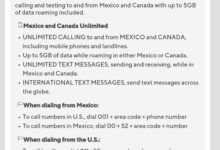A Comprehensive Guide to Staying Connected While Traveling
Contents
- 1 Hello, Readers!
- 2 Navigating the Maze of Connectivity Options
- 3 Table: Staying Connected While Traveling: A Comparison
- 4 Frequently Asked Questions
- 4.1 1. What is the best overall method for staying connected while traveling?
- 4.2 2. How can I avoid roaming charges on my mobile data?
- 4.3 3. What is the cheapest way to stay connected while traveling?
- 4.4 4. How can I stay connected on a budget?
- 4.5 5. What is the most reliable way to stay connected in remote areas?
- 4.6 6. Can I use my home country’s SIM card while traveling abroad?
- 4.7 7. What is the best hotspot device for travel?
- 4.8 8. What are the security risks of using public Wi-Fi?
- 4.9 9. Can I use a VPN to improve my Wi-Fi security?
- 4.10 10. What are the data usage limits on different connectivity options?
- 4.11 11. Is satellite internet available everywhere in the world?
- 4.12 12. What is the fastest way to stay connected while traveling?
- 4.13 13. Can I stay connected while on a plane?
- 5 Conclusion: Embracing Seamless Connectivity on Your Travels
- 6 Closing Words: Embark on Your Global Adventure with Confidence
Hello, Readers!
In our fast-paced, interconnected world, staying connected while traveling is paramount. Whether you’re a business professional, a vacationer, or an adventurer exploring the globe, access to communication and information is essential for a successful and enjoyable journey.
This comprehensive guide provides an in-depth exploration of the various methods available for staying connected on the road. We’ll delve into the pros and cons of each option, including Wi-Fi, mobile data, and satellite devices, to equip you with the knowledge to make informed decisions about how to stay connected throughout your travels.
With the advent of the internet and mobile technology, staying connected while traveling has become easier than ever before. However, navigating the complexities of different countries’ telecommunications systems can be challenging. This guide aims to provide clear, concise information to help you overcome any connectivity hurdles and ensure a seamless travel experience.
1. Wi-Fi
Wi-Fi is a wireless technology that allows devices to connect to the internet through a router. It is commonly available in public spaces such as airports, hotels, cafes, and libraries. The advantages of using Wi-Fi include its widespread availability, ease of use, and often free cost. However, it can be unreliable, slow, and vulnerable to security risks.
2. Mobile Data
Mobile data is a cellular network-based service that allows devices to access the internet through a mobile operator’s network. It provides faster and more reliable speeds than Wi-Fi but can be expensive, especially when roaming internationally. Data limits and roaming charges can also be a concern.
3. Satellite Devices
Satellite devices provide internet connectivity through a satellite network, making them ideal for remote areas with limited or no cellular coverage. They offer reliable and high-speed internet access but come with hefty costs, complex setup, and bulky equipment.
4. Local SIM Cards
Purchasing a local SIM card allows you to use the mobile network of the country you’re visiting. This can provide affordable and convenient data and voice services, but it requires switching your SIM card and potentially having to unlock your device.
5. Hotspot Devices
Hotspot devices, such as portable Wi-Fi routers, create a personal Wi-Fi network that multiple devices can connect to. They can be rented or purchased and provide a convenient way to share a data connection, but they rely on mobile data and can be expensive.
Table: Staying Connected While Traveling: A Comparison
| Method | Strengths | Weaknesses |
|—|—|—|
| Wi-Fi | Widespread availability, ease of use, often free | Unreliable, slow, security risks |
| Mobile Data | Faster and more reliable speeds | Expensive roaming charges, data limits |
| Satellite Devices | Reliable and high-speed internet access in remote areas | Hefty costs, complex setup, bulky equipment |
| Local SIM Cards | Affordable and convenient data and voice services | Requires switching SIM card, possible device unlocking |
| Hotspot Devices | Convenient way to share a data connection | Relies on mobile data, can be expensive |
Frequently Asked Questions
1. What is the best overall method for staying connected while traveling?
It depends on your budget, travel plans, and connectivity needs. Mobile data is a good option for most travelers, but Wi-Fi and local SIM cards can be more cost-effective, while satellite devices provide the most reliable connectivity in remote areas.
2. How can I avoid roaming charges on my mobile data?
Purchase a local SIM card, use a hotspot device, or enable your phone’s Wi-Fi calling and use Wi-Fi whenever possible.
3. What is the cheapest way to stay connected while traveling?
Use free Wi-Fi whenever possible and purchase a local SIM card for local data usage.
4. How can I stay connected on a budget?
Consider purchasing a hotspot device, using Wi-Fi calling, or opting for a data-only SIM card.
5. What is the most reliable way to stay connected in remote areas?
Use a satellite device or purchase a local SIM card from a reputable provider.
6. Can I use my home country’s SIM card while traveling abroad?
It depends on your mobile operator’s roaming policy. Check with your provider before you travel to avoid unexpected charges.
7. What is the best hotspot device for travel?
Look for a device with long battery life, reliable connectivity, and the ability to connect multiple devices simultaneously.
8. What are the security risks of using public Wi-Fi?
Public Wi-Fi networks can be vulnerable to eavesdropping and hacking. Avoid accessing sensitive information or banking websites on public Wi-Fi.
9. Can I use a VPN to improve my Wi-Fi security?
Yes, using a VPN (virtual private network) encrypts your internet traffic, making it more secure when using public Wi-Fi.
10. What are the data usage limits on different connectivity options?
Data usage limits vary depending on the provider and the type of plan you choose. Check with your service provider for specific details.
11. Is satellite internet available everywhere in the world?
No, satellite internet coverage varies depending on the satellite provider and the area you’re traveling to.
12. What is the fastest way to stay connected while traveling?
Mobile data generally provides the fastest internet speeds, but Wi-Fi can also be fast in areas with good coverage.
13. Can I stay connected while on a plane?
Some airlines offer in-flight Wi-Fi, but it can be expensive and unreliable. Consider purchasing a data plan or using a hotspot device if you need to stay connected during a flight.
Conclusion: Embracing Seamless Connectivity on Your Travels
Staying connected while traveling empowers you to navigate foreign lands, stay informed, and maintain communication with loved ones and business associates. By understanding the pros and cons of different connectivity options and utilizing the resources available to you, you can ensure a seamless and enjoyable journey.
Whether you’re a seasoned traveler or a first-time explorer, embracing the latest technologies and advancements will keep you connected throughout your adventure. Remember, staying connected is not just about convenience; it’s about enhancing your travel experience and creating lasting connections with the world around you.
Closing Words: Embark on Your Global Adventure with Confidence
In a world where borders are fading and the global village is expanding, staying connected while traveling is not a luxury; it’s a necessity. With the right knowledge and tools at your disposal, you can embark on your global adventure with confidence, knowing that the world is at your fingertips.
Stay informed, stay connected, and embrace the wonders that await you on your journey. May this guide serve as your trusted companion, empowering you to explore the world without losing touch with what matters most.







